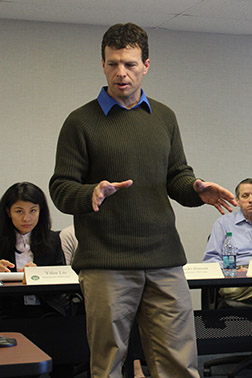New Director Assesses Priorities for Region
 |
|
Steve Young speaks at the meeting of the Advisory Council of the Northeastern IPM Center in Linthicum Heights, MD in November of 2014. Source: C. Gonzales, Northeastern IPM Center |
Steve Young, the new director of the Northeastern IPM Center, says that communication and education will be the defining tune as he takes to the podium to promote integrated pest management in the region.
That trajectory is evident in several recent moves the new director has made. As part of these initiatives, the Center is building a webinar series—a recent webinar on bed bugs attracted over 3,000 people. Print issues of the IPM Insights newsletter will arrive quarterly, and content will roll onto the web and through social media throughout the year. Young’s team is updating the website to make it more mobile friendly and streamline access to information.
“Ultimately, I want our Center to be the unifying spokesperson on integrated pest management for the region,” Young said.
Not every detail of work will happen online. The new director Young recently embarked on a two-week tour of the Northeast region to meet partners and stakeholders face to face.
“This work is valuable as we understand the priorities and look at what lies ahead,” Young said. “Our state IPM coordinators, researchers, Extension personnel, and supporters from federal agencies and the private sector are going to be critical to this process.”
Signature Programs
Young envisions five signature programs under which all efforts of the Center will be organized. The programs were shaped by the Steering Committee and informed by the Advisory Council at meetings in the fall of 2014. At present, the areas of focus for the programs are IPM and organic systems, rural and urban IPM, climate change and pests, next generation education, and advanced production systems.
IPM and organic systems: The Center is interested in the intersection of IPM and organic methods.
Rural and urban IPM: IPM works in all environments where food is produced and where people live, work, and play.
Climate change and pests: Changes in climate could bring shifts in the distribution and occurrences of pests.
Next generation education: Students and professionals trained and certified in the fundamentals of IPM will be critical in maintaining the knowledge base for the future.
Advanced production systems: This area is focused on how technology—from robots to geographic information systems to apps to computers to entirely new types of farming—could help advance the development and adoption of IPM.
“I have been telling people that we want to engage with them,” Young said. “We want to help them get their message out, support them in numerous other ways, and promote the adoption of IPM.”
— by CHRIS GONZALES
The Northeastern IPM Center promotes integrated pest management for reducing risks to human health and the environment. If republishing our news, please acknowledge the source (“From Northeast IPM Insights”) along with a link to our website.
